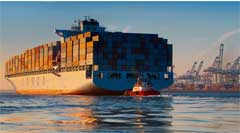Additional automation at US ports to speed the flow of containers and keep America more competitive versus other nations is needed – but for a variety of reasons, it just isn’t happening.
Supply Chain Digest Says... |
 |
|
| So it is highly unlikely we’ll see a surge in US port automation any time soon, which as noted above could have significant economic consequences. |
|
 |
|
What do you say? |
|
| Click here to send us your comments |
|
| |
|
| Click here to see reader feedback |
|
|
|
Case in point: Stopping the adoption of container handling systems was said to be a key issue for the International Longshore and Warehouse Union (ILWU) in its more than a year of negotiations with West Coast port and terminal interests.
While details of the new contract approved by union leadership in June have not been released as it awaits approval by the rank and file, the fact that the union seems quite pleased with the new six-year pact would seem to indicate it was resolved mostly in the ILWU’s favor.
But union opposition to port automation may be even stronger from the International Longshoremen’s Association (ILA), which represents dock workers at East and Gulf Coast ports.
According to a recent article in the Wall Street Journal at a July conference, ILA President Harold Dagget had this to say on the topic: “There’s going to be an explosion and the ILA and the dockers around the world are going to light the fuse. It’s time we put companies out of business that push automation.”
But labor opposition to port automation is hardly the only factor as to why US ports are generally thought to be behind leading facilities in Asia, Europe and even the Middle East.
Another factor, the Journal reports, has to do with a lack of space, with many US ports unable to add to their footprints.
“You’re going to give up a lot of terminal space while you are under construction,” an official at a Southern California terminal who declined to be identified told the Journal. “You’re going to have to sustain that loss of revenue for a period of time and getting the return on investment seems pretty difficult.”
Then there is this: many terminal operators themselves don’t seem all that interested in automation. While four of the 13 terminals at the Ports of Los Angeles and Long Beach have automated, the other nine are showing little enthusiasm, the Journal also reported.
(See More Below)
|
CATEGORY SPONSOR: SOFTEON |
|
|
|
|
|
 Those terminals, owned by container shipping lines or private investment firms, often say they can’t afford the billions of dollars required to acquire automated equipment. Those terminals, owned by container shipping lines or private investment firms, often say they can’t afford the billions of dollars required to acquire automated equipment.
They also claim their terminals are too small or oddly shaped for automation to deliver the productivity gains that would generate ROI from the investment. Even without those obstacles, in many cases it appears the expected ROI just never shows up for terminal operators.
So it is highly unlikely we’ll see a surge in US port automation any time soon, which as noted above could have significant economic consequences.
As industry consultant Jon Monroe told the Journal, “It [automation] will happen, whether it is in two years or 20 years, otherwise as a country we can’t keep up."
What are your thoughts on US port automation? Let us know your thoughts at the Feedback section below.
Your Comments/Feedback
|

